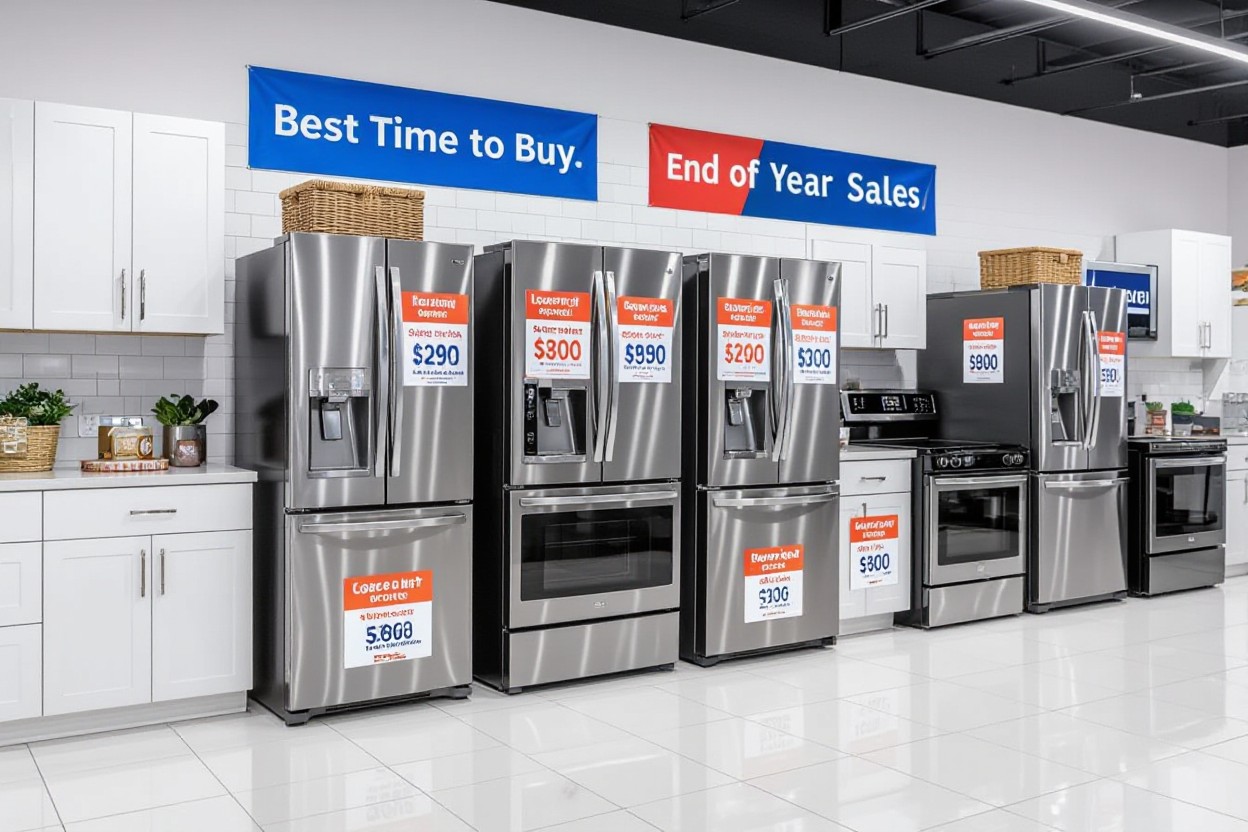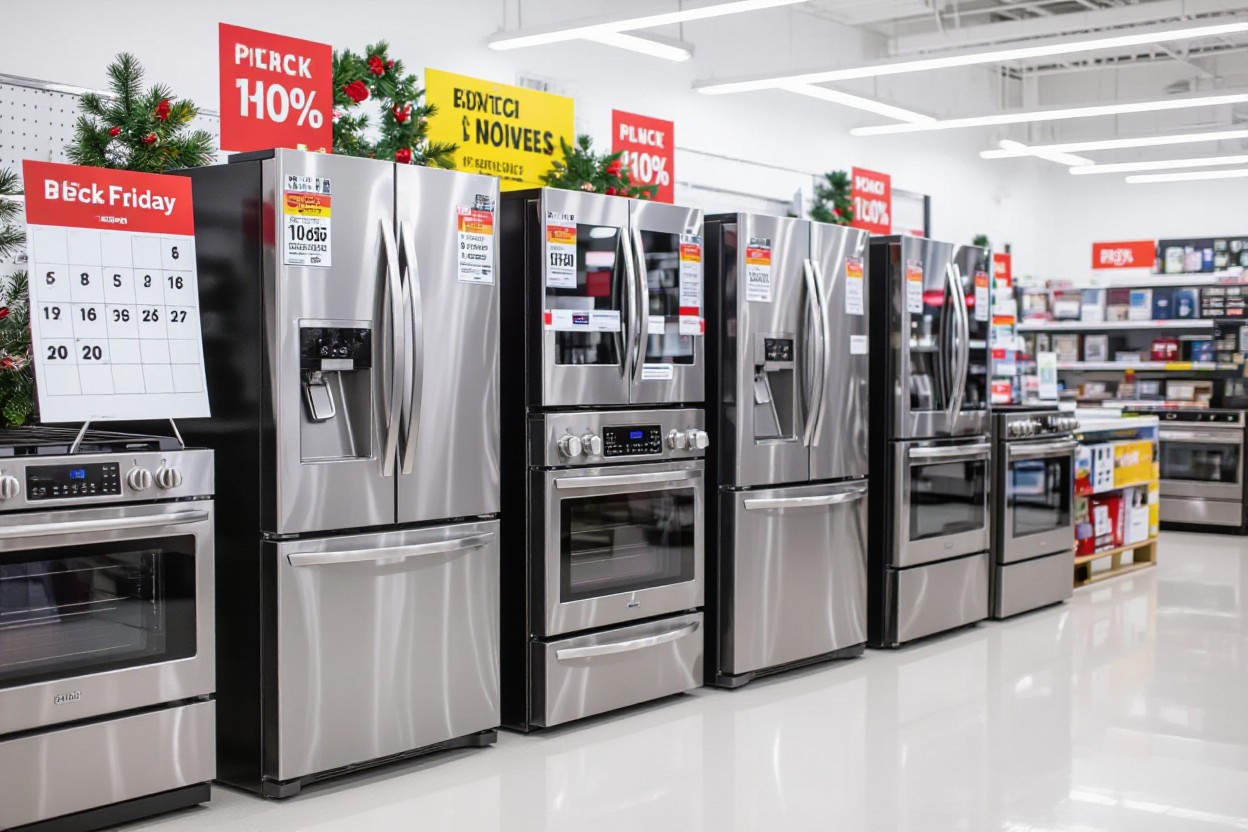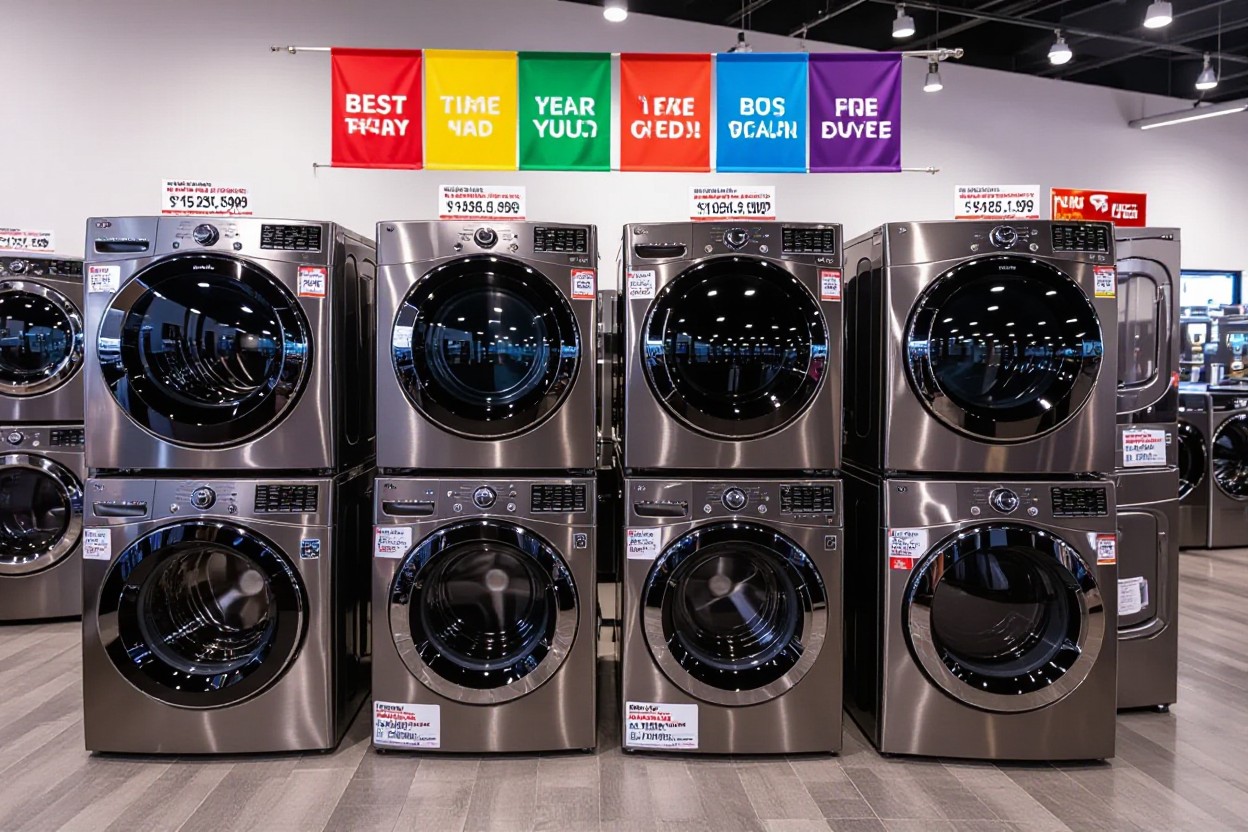The best time to buy large appliances often falls on major holiday weekends, though you can also find deals during September–December model changeovers, spring and fall off-seasons, and end-of-month or year clearances. Make sure you comparison-shop by checking the same product at other stores and online, ask sales staff about upcoming sales or open-box/floor models, and factor tariffs and supply-chain shifts into your timing so you get the lowest price possible.
>>>>>>>>>>Shop Now for the Best Appliance Deals<<<<<<<<<<<<
Seasonal Sales: When to Make Your Move
Major holiday weekends and specific seasonal windows produce the deepest appliance discounts, so you should plan purchases around those peaks. Track Presidents’ Day, Memorial Day, Fourth of July, Labor Day, Veterans Day, and Thanksgiving weekend (Black Friday through Cyber Monday). Always comparison shop online and in-store, ask sales staff about upcoming promos, and factor in tariffs or supply-chain pinch points that can limit inventory and affect final prices.
Major Holiday Weekends: Unmissable Opportunities
Holiday sales regularly deliver double-digit savings on large appliances; you can often find 10–30% off and occasional deeper “doorbuster” deals on floor models. Black Friday and Cyber Monday are the biggest events, but Presidents’ Day, Memorial Day, Fourth of July, and Labor Day each produce notable appliance markdowns. Check competitor pricing and online listings before you buy to confirm the best offer.
Seasonal Shifts: Fall and Spring Deals
September–December clears outgoing dishwasher, washer/dryer, and oven models as new lines arrive, while May is ideal for older refrigerator models. Spring and fall slow sales for A/Cs and furnaces, so you can often score lower prices and faster delivery on those units. Time your search to model-release months and you’ll capture manufacturer-driven discounts.
Retailers often discount older stock by 10–25% during transition months; new washers and dryers typically debut in September–October, ovens around January, and refrigerators in May. From June to July 2025, overall appliance prices fell 1.1% and major appliances dropped 2.4%, showing that seasonal pricing can swing quickly. You should monitor price trackers, sign up for store alerts, and ask about open-box or floor-model savings to maximize value.
Timing Your Purchases: Month-by-Month Breakdown
Plan your buys around product-release cycles and holiday weekends: dishwashers and washers/dryers refresh in September–October, refrigerators typically debut in May, and many ovens launch in January. Major holiday weekends (Presidents Day, Memorial Day, Fourth of July, Labor Day, Veterans Day, Black Friday/Cyber Monday) trigger broad appliance discounts, while end-of-month and September–December clearances clear out older models. Always comparison shop online and ask sales staff about upcoming sales.
The Best Months for Dishwashers and Refrigerators
New dishwasher models usually arrive in September–October, so you can snag last year’s units on discount then; refrigerators often debut in May, making late spring the best time to hunt clearance models. Target holiday weekends like Memorial Day and Black Friday for additional markdowns, and compare identical SKUs across retailers and online marketplaces to ensure the listed clearance is truly the lowest price for you.
Perfect Timing for Ovens, Washers, and Dryers
Oven model refreshes tend to occur in January, so you should shop early-year sales for prior-year discounts; washers and dryers refresh in September–October, aligning with fall clearance windows. Holiday sales and end-of-year inventory pushes can amplify savings on each category. Ask about open-box or floor models for extra savings and compare delivery and installation fees so you know your total outlay.
From June to July 2025, appliance prices dipped overall, down 1.1% and major appliances down 2.4% showing short-term windows to save; tariffs on steel and import duties can push washer and refrigerator prices higher, so weigh timing against projected inflation. If you consider switching to an electric oven, you may qualify for an $840 IRA rebate (100% if your household income ≤80% of the area median, 50% for 80–150%), which can make buying now more attractive.

External Forces: How Tariffs and Supply Chains Affect Prices
Tariffs and tangled supply chains have a direct effect on what you pay: tariffs now cover imports from more than 90 countries, and steel levies are pushing costs for washing machines and refrigerators upward. Even with a brief relief, appliance prices fell 1.1% overall and major appliances 2.4% from June to July 2025. You should comparison shop, check stock levels across retailers, and ask sales staff about upcoming promotions and delivery timelines.
>>>>>>>>>>Get Exclusive Discounts on Top Brands<<<<<<<<<<<<<<<
The Impact of Inflation on Appliance Costs
Inflation’s swings affect your sticker price: appliances fell 1.1% overall and major appliances 2.4% from June to July 2025, but tariffs on imports from over 90 countries, especially steel, mean washing machines and refrigerators could see higher costs. You should weigh timing: target older models in September–December or holiday weekends when retailers clear inventory if tariffs push retail prices upward.
Navigating Supply-Chain Disruptions
Supply-chain headaches shifted since COVID-19; some manufacturers shortened lead times, but recent import tariffs have created new bottlenecks, according to FreightWaves. Monitor SKU availability online, ask retailers for current lead times and shipping windows, and consider floor-model or open-box units if you need immediate replacement; off-season buying (spring for heaters, fall for AC) often yields faster delivery.
Ask for an estimated ship date in writing and a clear backorder policy; many retailers will issue a rain check to lock a sale price when stock runs out. Check nationwide inventory (some stores show SKU-level stock), compare online marketplaces for immediate availability, and verify delivery and installation windows so you can decide between waiting or taking a certified refurbished or open-box unit.

Smart Shopping Strategies: Maximizing Your Budget
Leveraging Off-Season Discounts
When you shop for seasonal items out of peak demand air conditioners in winter or furnaces in summer, retailers often mark prices down 15–25% to move stock; combine those off-season markdowns with holiday-weekend sales and end-of-month clearances to maximize savings. Use price-tracking tools, set alerts, and compare identical models across big-box stores and online marketplaces so you can pounce the moment a target price appears.
Exploring Rebates and Open Box Options
Federal and utility rebates plus manufacturer offers can shave hundreds to thousands off your cost. Examples include the $840 electric-stove rebate and $1,750 for heat pump water heaters under current programs, so check ENERGY STAR and your utility’s pages for eligibility and amounts. Open-box and floor models at retailers like Best Buy or Home Depot frequently sell for 10–30% less and may still carry limited warranties; always compare warranty coverage and return policies before committing.
Collect invoices, model and serial numbers, and submit rebate applications promptly. Some mail-in rebates take 6–8 weeks, and utility programs may require pre-approval. Inspect open-box units in person: test cycles or burners, look for dents, get the condition in writing, and confirm remaining manufacturer warranty or request a short-term store warranty; negotiating waived delivery or installation fees can boost net savings.

Comparison Shopping: The Key to Finding the Best Deal
Compare model numbers, specs, warranties, delivery and installation fees, return policies, and price-match guarantees across retailers and online marketplaces; holiday weekends and September–December clearances often produce the biggest markdowns, and asking a salesperson about upcoming promotions can reveal additional discounts you can combine with advertised sales.
Comparison Checklist
| Price & Promotions | Sale price, manufacturer rebates, coupons, tax, and final out-the-door cost |
| Model & Specs | Exact model number, capacity, energy rating, and feature differences |
| Fees & Services | Delivery, installation, haul-away, and extended-warranty costs |
| Policies | Return window, restocking fees, and price-match terms |
How to Effectively Compare Prices
Track the exact model number, set price alerts on Google Shopping or CamelCamelCamel, and compare final totals including delivery and installation; check retailer apps for exclusive coupons, verify price-match rules (some match online prices), and time purchases around holiday weekends, end-of-month, or model-changeover windows like September–December.
Tools & Tactics
| Price trackers | CamelCamelCamel, Honey, Google Price Alerts to catch dips |
| Retailer apps | Exclusive coupons and app-only flash sales |
| Ad proof | Screenshots or printed ads to invoke price-match |
| Historical timing | Holidays, end-of-year, and model-release months for best deals |
Tips for Using Credit Card Rewards
Choose cards with high welcome bonuses or elevated cash-back in home-improvement categories, meet minimum spends on planned purchases, and combine points with store rebates and cashback portals; look for cards offering purchase protection and extended warranties to reduce post-purchase risk.
- Use sign-up bonuses after confirming you can meet the minimum spend on the appliance purchase
- Pick cards offering 3–5% back in home improvement or rotating categories
- Redeem points as statement credits or gift cards to offset delivery/installation
- Perceiving stacking opportunities, use cashback portals before purchase to add incremental savings
Maximize value by stacking: run purchases through a cashback portal (Rakuten, TopCashback), pay with a rewards card that has purchase protection/extended warranty, then submit any manufacturer rebates; if the card offers 0% APR promotions, you can spread payments without interest, but always confirm any enrollment deadlines and fees.
- Check for cards that add 1–2 years of extended warranty on eligible purchases
- Verify price-protection benefits and claim windows (often 60–90 days)
- Use 0% APR offers only when you have a repayment plan to avoid interest
- Perceiving the net saving, add manufacturer rebates and retailer credits to your reward calculations
To wrap up
Upon reflecting, you should prioritize major holiday weekends for the deepest discounts, while also shopping September–December, spring/fall, and end-of-month/year clearance windows; always comparison-shop online and in stores and ask sales staff about upcoming sales or open-box options. Factor in tariffs and supply-chain shifts that can affect availability and pricing, and consider rebates and offseason buys to stretch your budget.